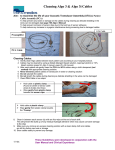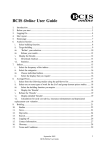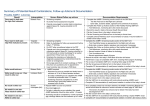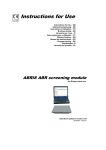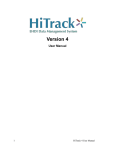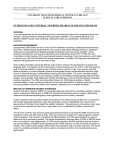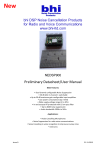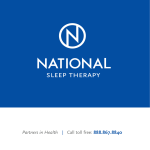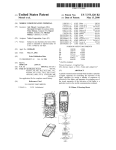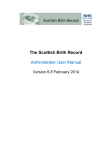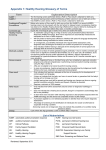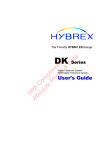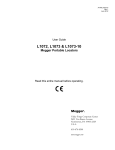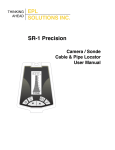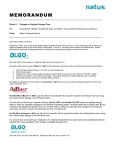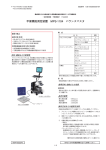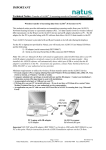Download Contract (prompt box* - contract name and number)
Transcript
HealthShare – Business Procurement Services Nerida Eames Contract Management Officer PO Box 1770, Chatswood NSW 2067 02 8907 1479 (D) or 02 8644 2000 [email protected] Contract 1001 Automated Auditory Brainstem Response Unit for the NSW State Wide Infant Screening – Hearing Program Contract 6 September 2010 to 5 September 2014 Page 1 of 23 Health User Period: Guide Version 4 With one January 2014 extension option of 12 months Table of Contents 1. Introduction ...................................................................................................3 2. Accessing the Contract ....................................................................................3 3. Placing an Order .............................................................................................3 4. Prices ...........................................................................................................4 5. Range of Products ..........................................................................................4 6. Technical Information ......................................................................................4 7. Contractor .....................................................................................................4 8. Contract Conditions ........................................................................................9 9. Frequently Asked Questions .............................................................................11 10. Contract Administration & Contractor Performance Survey ...................................11 Health User Guide Version 4 January 2014 Page 2 of 23 1. Introduction 1.1 This user guide is designed to provide customers with all the necessary information needed to utilise contract 1001 Automated Auditory Brainstem Response Unit for the NSW State Wide Infant Screening – Hearing Program (SWISH). 1.2 Health Support Services – Tendering & Contracting Team provides a full range of procurement services for NSW Health and other eligible organisations. Services include contract management of common use period contracts. These are period contracts on a rolling one to five year renewal cycle for the supply of products and services in common use across many agencies. Under these contracts, suppliers provide a range of products and services at prices established on the basis of aggregated whole of government buying power, achieving significant savings. 1.3 The Contract is for the supply of Automated Auditory Brainstem Response Unit for the NSW State Wide Infant Screening – Hearing Program for a term of 4 years expiring on 5 September 2014 with one, 12 month extension options. Pricing is fixed for the first 12 months of the contract then subject to review at twelve (12) monthly intervals. 1.4 This period contract allows users to achieve considerable cost savings if volume commitment triggers are achieved. It offers value for money including competitive rates, and a quality range of products. 2. Accessing the Contract 2.1 Period contracts are established under the authority of the Health Administration Corporation and administered by the NSW Department of Health. 3. Placing an Order 3.1 Official orders are to be placed with the Contractor through Oracle or Webreq. By placing an order you are entering into a contract with the supplier and as a minimum, the following information should be included in the Official Order: Contract Number and Name Name and address of Supplier and Customer Customer’s Order Number Date of Order and Date of Delivery Item, product code, contract price, quantity and any accessories HIMF number – please see below table. HIMF Number HIMF Generic Description 508809 EAR PHONE AND SENSOR PACK, NEWBORN HEARING SCREENING (VALU PAK) 532372 EAR PHONE AND SENSOR PACK, NEWBORN HEARING SCREENING (ALGO PAK) Health User Guide Version 4 January 2014 Long Description Consists of: 300 x Valu-Pak Earphones, pressure sensitive adhesive 960 x Jelly Tab Sensors, hydrogel adhesive 1 x Baby Preparation Guide Consists of: 36pr x FlexiCoupler Hydrogel Earphones disposable 120 x JellyTab Sensors hydrogel adhesive 1 x Baby Preparation Guide Organisation Assigned BLK, BRH, CHR, CHW, FWT, HOR, HSC, HWA, HWM ILS, MUR, NBM, ORA, SEI, SES, SOU, SSW, SWS, SYD, WAG, WMD, WST, WSY BLK, BRH, CCO, CHR, CHW, FNU, HCA, HNE, HOR, HSC, HSP, HSU, HWA, ILS, MNC, MUR, NBM, LIS, NCC, NEW, NSY, ORA, PTM, SEI, SES, SOU, SWS, SYD, SSW, TAM, WAG, WMD, WST, WSY Page 3 of 23 4. Prices 4.1 Prices are subject to variation and will change in accordance with the price variation conditions of the contract. Always ensure you obtain the latest version of the User Guide before making a purchase. Updated versions of this and other User Guides are available from the contact officer above. 5. Range of Products 5.1 The range of products/services available under the contract include: Category Name AABR Equipment Accessories Consumables Rental • Free Into Store: The pricing of all items on this Contract is Free Into Store (FIS). • GST free pricing: All items on this Contract are GST free. • Latex Free: All items and packaging on this Contract are latex free. • Therapeutic Goods Administration (TGA): All items on this Contract are TGA listed. 6. Technical Information Technical information is provided in Attachment 1 of this user guide. 7. Contractor There is only one supplier under this contract, Scanmedics Pty Ltd. Health User Guide Version 4 January 2014 Page 4 of 23 Scanmedics Pty Ltd Australian Business Number (ABN) Registered Office (if a company) Site Address (principal place of business) Postal Address (principal place of business) Contract Administration Contact Name Contract Administration Contact Telephone No. Contract Administration Contact E-mail Address Sales Order Contact Name Sales Order Phone Number Sales Order E-mail Address Sales Order Fax Number Switch Board Telephone Number Company Website Address 54002598914 30 Blake Street, Wagga Wagga 2650 Unit 6, 15-17 Gibbes Street, CHATSWOOD NSW 2067 David Gibson 02 98822088 [email protected] Alison Offner 98822088 [email protected] 98823549 02 98822088 http://scanmedics.com/ 7.1 Guarantees and Servicing Arrangements: All devices offered are warranted against faulty manufacture or components for 12 months from the date of invoice. Consumables are time sensitive and as such are warranted against faulty manufacture or components up to the expiry date listed on the packaging. 7.2 Price Basis: Please see attached Excel sheet for prices. Price Variation Mechanism: Prices are firm for the first twelve (12) months of the Standing Offer agreement then subject to review on a yearly basis at 12 monthly intervals, based on Exchange Rate variation. 7.3 Service and Replacement Pricing: Services Full Service contract ALGO 5 Full Service contract ALGO 3i ATA cables calibration Product ID NATSERA5F NATSERA3iF NATSER ATACAL $ $ Price (Ex GST) 2,424.00 1,515.00 Notes: Full service contract includes annual calibration and "fair use" replacement of cables and other components of the device. Basic service contract Includes all components of the device except cables and does not include annual calibration fees ATA calibration fee includes calibration but does not include replacement of faulty cables. See replacement purchases table on page 6. The list of standard items included in the device packs are as follows: ALGO 3i (Part number NATALGO3i)* Algo 3i USB-Serial Adapter Serial-IR Adapter Sample Pack IEC Power cable x 2 Label printer Roll stand adapter Check Kit Health User Guide Version 4 January 2014 ALGO 5 (Part number NATALGO5)* Sample Pack IEC Power cable Label printer Check Kit Algo 5, including cart, keyboard and monitor ATA cable PCA cable User Manual CD Page 5 of 23 Preamp CD installation guide ATA cable Quick reference guide PCA cable ATA certificate of calibration User Manual CD CD installation guide Quick reference guide ATA certificate of calibration A3i Backpack carry case Power pack/Battery charger Printer-IR adapter *Annual calibration at the end of the first 12 months use is included in the purchase price Below is the list of accessories for replacement purchase as required: Accessories Desktop printer, Seiko, for A3i (power cord not included). Power cords are listed individually, P/N#'s 700090, 700091, 700092, 700138. Pre Amp 3i Cable, short version ATA3 (Acoustic Cable) ATA 3i Cable, short version Patient Connection Assembly (PCA) 3 Cable Pre Amp 3 Cable ALGO 3i rollstand adapter Assy, USB to Serial CBL Kit, A3i CBL, IR Dongle PTR SLP-200, A3i Cable, IR Adapter, DUS, A3i Cable, USB/RS232 Adaptor, DUS, A3i ALGO Equipment Check Kit ALGO 3i battery charger w/o power cord ALGO 3i Li-Ion battery ALGO 3i carrying case (backpack) Cable protection pouch Power cord, AU (power cord for Seiko desktop printer and A3i battery charger) Power supply for Seiko printer Printer Labels for Seiko Printer (one roll contains 140 labels) Soft Clip, A3i ATA 5 (Acoustic Cable) PCA 5 (Patient Cable) PreAmp 5 Cable Page Printer Inkjet Page Printer Laser Barcode Scanner LAN Isolator ADAM, stand-along data management program for A3 and A3i Trolley – wheeled height adjustable pole with two baskets IV Pole with Ramshead wheels Dressing Trolley, stainless steel, with leg mounted IV pole socket and IV pole Health User Guide Version 4 January 2014 Product ID Price (Ex GST) TGA# NAT040882 NAT040656 NAT040520 NAT040655 NAT040740 NAT030697 NAT040710 NAT040769 NAT030670 NAT900617 NAT900624 NAT040527 NAT900611 NAT900610 NAT030672 NAT030695 $ $ $ $ $ $ $ $ $ $ $ $ $ $ $ $ 1,008.58 971.83 1,866.67 1,866.67 245.00 971.83 228.67 105.00 266.00 266.00 157.50 81.67 285.83 163.33 98.00 27.77 NAT700138 NAT900616 $ $ 35.00 57.17 172694 NAT900404 NAT030683 NAT000699 NAT000696 NAT000698 NAT040950 NAT040951 NAT040947 NAT040948 $ $ $ $ $ $ $ $ $ 40.83 75.79 1,866.67 245.00 971.83 269.50 939.17 530.83 686.00 172695 172689 172687 172674 172683 172685 172697 172696 172690 NAT040927 $ 2,438.33 NATBR736 NATPOLEIV NATTROSS/ NATTROPC $ $ 700.00 250.00 $ 730.00 172685 172683 172687 172687 172674 172683 172689 172690 172690 172690 172690 172724 172693 172691 Page 6 of 23 Consumables ALGO-Pak screening supplies Each box contains 36 sets of FlexiCoupler™ disposable hydrogel earphones and 40 triplets JellyTab™ sensors. One case equals 8 boxes. VALU-Pak screening supplies - each box contains 300 sets of Valu-Pak pressuresensitive neonatal adhesive and 320 triplets JellyTab™ sensors JellyTab™ Sensors 40 triplets NuPrep™ Prepping Gel, 4 oz tube NuPrep™ Prepping Gel, 25g tube Health User Guide Version 4 January 2014 Product ID Quantity Price (Ex GST) TGA # NAT040546 Box 36 $ 529.20 172629 NAT040670 NAT040587 NATNuPrep4 NATNuPrep25 Box 300 Box ea ea $ $ $ $ 4,130.00 163.33 58.80 34.30 172629 172629 172743 172743 Page 7 of 23 7.4 Volume Break Discounts: Note that discounts are only offered on consumables: Consumables ALGO-Pak screening supplies Each box contains 36 sets of FlexiCoupler™ disposable hydrogel earphones and 40 triplets JellyTab™ sensors. One case equals 8 boxes. VALU-Pak screening supplies - each box contains 300 sets of Valu-Pak pressuresensitive neonatal adhesive and 320 triplets JellyTab™ sensors JellyTab™ Sensors 40 triplets NuPrep™ Prepping Gel, 4 oz tube NuPrep™ Prepping Gel, 25g tube 7.5 Price (Ex GST) 10,000 units 25,000 units 50,000 units 100,000 units NAT040546 $ 529.20 $ 529.20 $ 521.26 $ 513.32 $ 502.74 NAT040670 $4,130.00 $4,130.00 $4,068.05 $4,006.10 $3,923.50 NAT040587 $ 163.33 $ 163.33 $ 160.88 $ 158.43 $ 155.17 NATNuPrep4 NATNuPrep2 5 $ 58.80 $ 58.80 $ 57.92 $ 57.04 $ 55.86 $ 34.30 $ 34.30 $ 33.79 $ 33.27 $ 32.59 Product ID Delivery: FIS, No minimum order fee. 8.1.1 • • Standard Arrangements Sydney Metro Area; 24 hours Regional NSW; 48 hours • • Emergency Arrangements Sydney Metro Area; 12 hours Regional NSW; 24 hours 8.1.2 7.6 Help Desk: 02 98822088 7.7 In-service Education and Training: A basic outline of the training progression is encompassed in the following points: Train the Trainer’ model. Goal: To develop a self sustaining programme that promotes long term programme viability. This includes advanced preparation of core components e.g. why you screen, rationale for early detection, didactic training, practical training and consolidation of all of these areas. (see Appendix G, Scanmedics Training Overview Document). Training incorporates the involvement of relevant professionals, such as the Audiologists. The Health User Guide Version 4 January 2014 Page 8 of 23 training is designed to create a full understanding of the entire screening pathway from initial screen to diagnosis and intervention. As programmes evolve and develop, we tailor our training on a consultative basis to best support these processes. Training is evidence based and promotes best practice and highest quality improvement in accordance with current JCIH 2007 recommendations and those of the individual programmes. Programme Specific Training. Goal: Individual ‘programme’ Specific training and consolidation. As individual programmes start to develop beyond initial training, our experience has demonstrated that Programme Managers identify unique areas that may benefit from more ‘programme’ specific training. The areas of specific need are identified and addressed through consultation between programme coordinators and Scanmedics. This training may address such things as ‘Trouble Shooting’, ‘Risk Factors’ and ‘Parental Communication’ in the format of workshops and seminars and is provided as identified. Ongoing Professional Development. Goal: Improve programme quality Outcomes to promote a progressive and forward thinking working UNHS environment. Current standards are reviewed in an environment which encourages continued educational growth of screening personnel and programme performance. Motivation is enhanced through the exchange of both personal and programme experience. Information is exchanged in a structured and productive manner, which facilitates positive change within UNHS programmes. Opportunities are provided to bring guest speakers from pertinent areas (neonatal, paediatric, audiology, parental) together with screening personnel, to educate in the diversities and the challenges of other national and international programmes. Areas that have proven to be of value include ‘risk factors for hearing loss’ (e.g. CMV, Craniofacial anomalies), risk management, language outcomes for children identified in a UNHS programme and parental experience within the screening pathway. Scanmedics have also had the opportunity to provide national and international guest speakers specialising in all areas of screening, diagnosis, intervention and outcomes. A total of 12 presentations have been arranged by Scanmedics to facilitate ongoing education and speakers have included Dr. Judith Marlowe (Florida, United States), Professor Christie Yoshinaga-Itano (Colorado, United States), and Dr. Pamela Palasanthiran (CMV specialist at Sydney Children’s Hospital, Australia). The details regarding presentation content and participant evaluation forms are listed in Appendix H. Ongoing Technical and Clinical Communication Updates. Goal: To provide the most current technical updates and clinical information. Programmes are updated on any technical aspects of the screening equipment including software and hardware changes which enhance the use of the device (Appendix I, Scanmedics -‘Acoustic Transducer Assembly document) Ongoing updates to Coordinators are also provided by utilising electronic distribution of other relevant upcoming events (e.g. national conferences, workshops and clinical articles, JCIH). 8. Contract Conditions This section contains the key features of the contract conditions that may be of interest to customers. It does not contain all of the conditions of contract (a copy of which can be obtained by contacting Contracting Services). Health User Guide Version 4 January 2014 Page 9 of 23 8.1 Government Taxes, Duties and Charges: All taxes, duties and charges imposed or levied in Australia or overseas in connection with the performance of this Agreement will be borne by the Contractor. 8.2 Title and Risk: Title and Risk shall pass to the Customer on satisfactory delivery of the Deliverables in accordance with the Customer Contract. 8.3 Insurance - The Contractor has arranged with a reputable insurance company: a) A Broad Form Liability Insurance Policy for at least the amount of $AUS20M in respect of each claim, for both Public Liability and Product Liability; b) Worker’s compensation insurance as required by all relevant laws of Australia relating to worker’s compensation. 8.4 Price Variations: The following price variation conditions apply a) As per the contractors selected price basis in accordance with Clause 3.5 Price Adjustment, of the Deed of Agreement. Note that pricing is fixed for the first twelve months of the contract then subject to review at six monthly intervals. 8.5 Best Price: Clause 3.6 Best Price, of the Deed of Agreement is applicable for this contract. 8.6 Free Into Store: The pricing of all items on this Contract is Free Into Store (FIS). 8.7 GST free pricing: All items on this Contract are GST free. 8.8 Latex Free: All items and packaging on this Contract are latex free. 8.9 Therapeutic Goods Administration (TGA): All items on this Contract are TGA listed. 8.10 Delays and Emergencies: From time to time the supply of goods from the Contractor may be delayed. The Contractor will take all reasonable steps to minimise the effect of the delays. An excusable delay is one which: a) Unavoidably delays the Contractor in the performance of its obligations under the Agreement; b) Is beyond the reasonable control of the Contractor; and c) Could not have been reasonably contemplated or allowed for by the Contractor before entering into the Agreement. The Contractor will inform you of the occurrence of any event, which is likely to adversely affect its performance of its obligations under the Agreement. If you consider that the event, which the Contractor claims to be the cause of the delay, is such as to justify an extension of the time for the delivery of the supplies, you may grant and notify the Contractor of such extension of time (usually within 2 working days after receipt of the Contractor’s claim for an extension). 8.11 Settlement of Disputes: If a dispute arises then both you and the Contractor must use your best efforts to resolve the dispute. Try to resolve the matter through discussions with the Contractor’s Customer Service Representative (see Section 4 for contact details). If, however, you are unable to resolve the matter then you should contact Contracting Services. If the matter cannot be resolved by mutual agreement of both parties in Health User Guide Version 4 January 2014 Page 10 of 23 consultation with Contracting Services the matter will be referred to expert determination. This more formal process will require you to keep a higher level of detailed documentation and records. 9. Frequently Asked Questions Q: How can I get the latest copy of the User Guide? A: Please contact the contract officer listed at the front cover to obtain the latest copy. Q: What if I am experiencing an issue with a supplier such as incorrect pricing? A: Please contact and report the issue to the contract officer for appropriate action. 10. Contract Administration & Contractor Performance Survey 10.1 Contact Numbers: The Contract has been arranged and is administered by Health Support Services. If you have any questions relating to the operation of the Contract then contact Contract Officer: Nerida Eames T: (02) 8907 1479 E: [email protected] 10.2 To help us maintain a high level of service we seek your feedback concerning suppliers’ performance under contracts established by the Health Administration Corporation. 10.3 Your feedback will be acknowledged within 10 days. Health User Guide Version 4 January 2014 Page 11 of 23 Performance Survey CONTRACT DETAILS Contract Number: 1001 Contract Name: Automated Auditory Brainstem Response Unit for the NSW State Wide Infant Screening – Hearing Program *Order Number : *Order Description: *Date of Order: *Value: *Completion Date: (*Complete where applicable for orders placed under Standing Offers) SUPPLIER'S DETAILS: Mr. David Gibson Scanmedics Pty Ltd ABN: 54002598914 T: 02 98822088 CLIENT DETAILS Contact Name: Telephone: Fax: e-mail: Reporting Area Health Service/Hospital: SUPPLIER’S PERFORMANCE (please mark selected rating with an “x” ) Question RATING Unsatisfactory Marginal Satisfactory Good Superior n/a Quality of Services/Goods delivered Time Management/Delivery Customer Service Contract Management and Compliance Warranty and Maintenance Services Overall Performance Health User Guide Version 4 January 2014 Page 12 of 23 Contract No: 1001 AABR-SWISH Overall Comments (attach a separate sheet if necessary) Reporting Officer: In my opinion: Health User Guide Version 4 January 2014 Page 13 of 23 Attachment 1 Technical Information 1 Mandatory Requirement Ease of Use 1.1 Does AABR unit provides a pass/ refer result upon the conclusion of the test, and can be used by nonaudiology trained staff? 1.2 Does the AABR unit has intuitive controls and software? 1.3 1.4 The AABR unit requires at least two levels of access: 1. A basic level for screeners which uses preconfigured settings defined by the Department; 2. An advanced level with restricted access (by password) so that trained personnel can override preconfigured settings. The unit should reset automatically to the default settings. 35dBHL Pass/Refer criteria. It is mandatory that the AABR units provide a pass/refer result based on criteria of 35dBHL. 1.5 Please list any other configuration parameters which can be changed. Health User Guide Version 4 January 2014 The ALGO 3i and ALGO 5 have both been approved by the US Food and Drug Administration (FDA) specifically for use by non-audiological staff trained to operate the device. The ALGO 3i has won an Industrial Design Award for this purpose. Whilst the FDA has no bearing on Australian approval, it is our understanding that many other so-called Automated ABR devices do not have FDA clearance for automated ABR and a condition of their FDA approval requires that a qualified person interprets the results. The ALGO 5 was developed to meet the requirements of New South Wales Health, based on feedback forwarded to Natus over the last 8 years during which NSW Health has used ALGO devices in the SWISH programme. A pass/refer result based upon statistical detection of the ABR response is automatically provided at the completion of each screen and the ALGO is FDA certified such that no interpretation of results is required (refer to User Manuals: ALGO 3i p.8, ALGO 5 p. 4). The software on ALGO AABR devices provides visual and written prompts to help guide screening personnel through the entire screening process. The device also alerts the user to any condition which requires their attention during the screen such as high impedance level, high ambient noise and high myogenic activity. Additional prompts are provided throughout the screen and more detailed information can be found in the relevant sections of the User Manuals (ALGO 3i p.57, ALGO 5 p. 34) and “Instructions for use Quick Guide” (appendix A). ALGO 3i: A “User Preferences” password is required to allow program managers/coordinators to make adjustments to time & date details. An advanced level "Biomedical Preferences” password is used to allow access to required fields and screening parameters (refer to User Manual ALGO A3i p. 42 ‘Device set-up’). The units can be preconfigured with relevant passwords and parameters to reflect the particular needs of NSW Health prior to delivery. ALGO 5: The ALGO 5 screener is highly customisable and Biomedical level password access is required to allow changes to the configuration settings. A User level password can also be configured. The main preference menu consists of seven choices including ALGO 5 preferences, data management preferences, field label editor, user manager, profile manager and system control (refer to User Manual ALGO 5 p. 69 ‘Preferences & Profiles’). The layout of the patient data window can also be customized to suit individual screening programs. The statistical detection algorithm used in all ALGO devices, including the ALGO 3i and ALGO 5, was designed and validated specifically for newborns and infants up to age of 6 months birth age to provide a pass/refer result based on a screening level of 35 dBHL and to identify babies with a developmentally significant hearing loss [1, 2]. Both the ALGO 3i and ALGO 5 will revert to the default settings as configured under the password protected function. Password protected adjustments can be made to technical parameters such as:- ALGO3i: Screening intensity level (ALGO 3i only):35 or 45dBHL. Simultaneous, Sequential or Separate ear screening (defaults to simultaneous screening mode). For more detailed information please refer to the User Manual (ALGO A3i p. 20). ALGO 5:Password protected settings. 1). Simultaneous, Sequential or Separate ear screening can be selected. The system defaults to simultaneous screening mode. 2). If the Left Ear/Right Ear Only Screening Mode should be available during the screening process. For more detailed information please refer to the A5 User Manual (ALGO A5 p. 71-72 ‘Preferences & Profiles’). NOTE: Current screening recommendations by the JCIH 2007 Position Statement are for bilateral screening, including rescreens [3]. For this reason, single ear screening methods are hidden by default. (Ears come in pairs). 3). If the sweeps or likelihood ratio (LR) should be displayed on the screening window (please refer to ALGO 5 User Manual p. 69-93 for more information on all levels of customisation that are available.). Page 14 of 23 1.6 Does the screening test take minimal time whilst maintaining accuracy? Please provide evidence of average time taken to complete test and the conditions for achievement of this accuracy and average time. ALGO AABR has automatic mechanisms in place to control for excess electrical, myogenic and ambient noise. An advanced artefact rejection system has been incorporated into the AGO 3i and ALGO 5 to manage the influence of myogenic and ambient noise [4]. These systems protect the data being collected from contaminating interference [5]. This ensures the data being analysed is optimised, the screen maintains accuracy, and the test time is kept to a minimum even when something in the environment changes (for further details please refer to the User Manuals: ALGO 3i p. 58, ALGO 5 p. 46). ALGO Acoustic Transducer Assembly (ATA) cables contain microphones that sense ambient noise in the environment. Ambient noise exceeding approximately 50dB SPL measured inside the ear-coupler will cause the statistical detection algorithm to temporarily disregard the evoked response signal until the noise level decreases to below 50dB SPL. The ear-couplers used to present the click stimuli to the ear provide some insulation from ambient noise in the screening environment, which would not otherwise be provided if an ear tip was used. Excessive electrical and myogenic noise is also automatically detected and again the algorithm temporarily disregards the evoked response signal until the electrical and myogenic activity are within acceptable levels. The operator is alerted to excessive acoustic, electrical and myogenic interference through a visual display on the device which prompts them to take steps to calm the infant or eliminate interference. Both the visual alerts and advanced artefact rejection system help to prevent unnecessary referrals to Audiology (high refer rates). The operator is not able to override the automatic artifact rejection mechanisms. ALGO is designed for any available location, including the NICU/special care nursery and post-natal ward and does not require acoustical isolation. Restrictions on use:- A reasonably settled infant is a prerequisite for successful UNHS screening with any device. It is indicated that the ALGO not be used in an environment where it continuously displays myogenic interference (muscular and electrical) or excessive ambient noise. The ALGO should not be used on infants less than 34 weeks gestational age or greater than 6 months (see 1.9 & 1.10 below). Technical 1.7 Does the AABR unit have automatic mechanisms in place to control for excess electrical, myogenic and ambient noise? - Please describe and specify levels of immunity. - Are there any restrictions on the use of the AABR unit? 1.8 Does the AABR unit interfere with any other electrical equipment? Please provide evidence of compliance to standards or equivalent. ALGO AABR has automatic mechanisms in place to control for excess electrical, myogenic and ambient noise. An advanced artefact rejection system has been incorporated into the AGO 3i and ALGO 5 to manage the influence of myogenic and ambient noise [4]. These systems protect the data being collected from contaminating interference [5]. This ensures the data being analysed is optimised, the screen maintains accuracy, and the test time is kept to a minimum even when something in the environment changes (for further details please refer to the User Manuals: ALGO 3i p. 58, ALGO 5 p. 46). ALGO Acoustic Transducer Assembly (ATA) cables contain microphones that sense ambient noise in the environment. Ambient noise exceeding approximately 50dB SPL measured inside the ear-coupler will cause the statistical detection algorithm to temporarily disregard the evoked response signal until the noise level decreases to below 50dB SPL. The ear-couplers used to present the click stimuli to the ear provide some insulation from ambient noise in the screening environment, which would not otherwise be provided if an ear tip was used. Excessive electrical and myogenic noise is also automatically detected and again the algorithm temporarily disregards the evoked response signal until the electrical and myogenic activity are within acceptable levels. The operator is alerted to excessive acoustic, electrical and myogenic interference through a visual display on the device which prompts them to take steps to calm the infant or eliminate interference. Both the visual alerts and advanced artefact rejection system help to prevent unnecessary referrals to Audiology (high refer rates). The operator is not able to override the automatic artifact rejection mechanisms. ALGO is designed for any available location, including the NICU/special care nursery and post-natal ward and does not require acoustical isolation. Restrictions on use:- A reasonably settled infant is a prerequisite for successful UNHS screening with any device. It is indicated that the ALGO not be used in an environment where it continuously displays myogenic interference (muscular and electrical) or excessive ambient noise. The ALGO should not be used on infants less than 34 weeks gestational age or greater than 6 months (see 1.9 & 1.10 below). Both ALGO® 3i and ALGO® 5 screeners comply with EN60601-1-2. EN 60601-1-2 is an international standard for use by manufacturers of medical electrical equipment, test houses, and hospitals that connect equipment up to form medical electrical systems. EN 60601-1-2 applies to the basic safety and essential performance of medical electrical equipment (ME equipment) and medical electrical systems (ME systems). EN 60601-1-2 applies to electromagnetic compatibility (EMC) of ME equipment and ME systems. EN 60601-1-2 specifies the general requirements and tests for electromagnetic compatibility of ME systems and ME equipment. Equipment Algorithm Health User Guide Version 4 January 2014 Page 15 of 23 1.9 1.10 Is the algorithm and stimulus level able to detect hearing loss in the moderate to profound range in infants from birth to 3 months of (corrected) age? Please provide evidence. Please provide information on the minimum and maximum ages that the algorithm will support. Please provide validation for these ages. 1.11 Please provide the mathematical basis behind the pass/refer decision for the algorithm used in the AABR unit. Provide evidence supporting testing of this algorithm. 1.12 Please provide details of screening sensitivity and specificity, and evidence underpinning these figures. Health User Guide Version 4 January 2014 Unlike other newborn hearing screening devices, the algorithm within the ALGO has been designed specifically based on the normal maturational changes of the infant auditory brainstem response (ABR) during the first 6 months of life. This enhances the accuracy of the ALGO for screening the newborn population. The algorithm in the ALGO AABR devices has been validated to detect infants with a hearing loss in the moderate to profound range from 34 weeks gestational age to 6 months inclusive [1, 2, 6-9]. The algorithm has been validated so that it can be used on infants aged 34 weeks gestation up to 6 months of age [1, 10-14] (please refer also to the ALGO User Manuals: ALGO A3i ‘Intended Use’ p. 6, ALGO 5 ‘Intended Use’ p.1). Binomial statistics were chosen for the ALGO AABR algorithm because of the significantly reduced chance of passing a hearing impaired baby whilst achieving low false positives (refer) rates [15]. Theoretically the chance of passing two deaf ears in the same baby is one in a million. Unlike other ABR devices, ALGO uses a unique patented, proprietary approach based on binomial statistics to automatically detect the newborn ABR. In conventional ABR, incoming evoked response from the baby is averaged on the theory that the very tiny ABR signal will become detectable despite the background (EEG) in which it is embedded. Unfortunately, since everything picked up by the electrodes goes into the averaging, signals with large amplitudes (noise) will carry more influence than smaller signals. By way of analogy, this would be the equivalent of giving tall people more votes than short people. Most importantly, if the large amplitude signals are sufficiently periodic and intense they can mimic an ABR sufficiently to mislead the examiner. With ALGO AABR, amplitude is not influential. Incoming evoked potentials recorded from the sensors each have a single vote; 0 if only noise is detected and 1 if an ABR is detected. The polarity and timing of the evoked response is the basis for detection and the statistical test that determines if the criteria of >99% likelihood of true ABR has been reached. Only then is the pass result obtained. With other Automated ABR methods, analysis using the frequency content of the response can be susceptible to mistaking interference for a true response and thus incorrectly passing a baby with a significant hearing loss. For more information comparing the accuracy of other analysis methods see reference [16]. Based on peer reviewed publications using the ALGO AABR device, the sensitivity is reported to be 100% and the specificity has been reported to be between 94 -96.7% [10, 13]. Additional information regarding the detection rates in the VIHSP have also been provided by Dr. Melinda Barker (see Appendix C). - It is important to note that the inventors of the ALGO AABR algorithm were clinical and academic professionals affiliated with Harvard University and the Massachusetts Eye and Ear Infirmary rather than beginning as a commercial entity. The ALGO was the very first Automated ABR newborn hearing screening device that went through the validation process required to obtain Food and Drug Authority (FDA) approval in the US and is thus considered to be the “De Novo” device. The significance of being a “De Novo” device is that the most rigorous processes of validation were required in order to gain FDA approval for the ALGO AABR device to be used on newborns, after which other automated ABR devices were able to follow without such rigorous scrutiny. - Equipment Validation, Sensitivity & Specificity. What does it mean to the whole program?- For a device to be validated it needs to go through a process whereby assessors compare the performance of the device against the most relevant competencies and standards. In the case of newborn hearing screening devices the gold standard for validation is to compare the result obtained from the device to that of a conventional auditory brainstem response (ABR). Studies should also include infants both with and without a hearing loss in the evaluation process to ensure the sensitivity of the algorithm to the target condition is high. Without these studies the end user may be put in the position whereby they have to recall a population of babies for repeat evaluations to ensure that no newborn with a hearing loss has incorrectly passed their hearing screen. This outcome is both detrimental to the long-term future of the baby and the confidence of the public in the newborn hearing screening program as a whole. From a program cost perspective the specificity of the algorithm within the device also needs to be validated so that program managers can ascertain what demand the screening process is likely to place on follow-up services. Lower specificity (higher refer rates) not only cause unnecessary parental concern but increase the work-load on screening personnel to repeat the screen and increase waiting times to diagnostic audiology services. Overall, the equipment validation process should demonstrate that, in the real working environment, the device is able to refer the lowest number of babies for follow-up testing with the greatest level of confidence. The ALGO AABR algorithm has undergone independent validation studies using the goldstandard conventional ABR in both the neonatal intensive care and well baby setting. The Page 16 of 23 sensitivity and specificity determined during these studies have been documented in international peer-reviewed publications [1, 10-13, 17, 18] thus providing program managers with the greatest level of confidence regarding the information they are working with. 1.13 1.14 Please provide technical documentation of the equipment algorithm. Please provide information on the limitations of the AABR unit to screen infants with craniofacial abnormalities at birth to 3 months of (corrected) age is provided. Please justify your response. ALGO devices have been specifically designed and validated to be used on babies with no syndromic features, including cranio-facial abnormalities [19]. The manufacturer is required to submit to regulatory authorities (FDA in the U.S.) all "claims" that relate to the performance of the device, its accuracy, and safety. Remembering that the ALGO was the first (and only) ABR device with fully automated results and intended for use by non-professional personnel, Natus qualified how the device should be used, in keeping with appropriate clinical practice (see User Manuals: ALGO 3i ‘Intended Use’ p.6, ALGO 5 ‘Instructions for Use Quick Guide -‘Selecting Optimal Screening Conditions’) This continues to mean that the approved and validated purpose of the device is screening exclusively. Thus, by definition of screening, the ALGO device is intended for use on an asymptomatic population in order to separate those most likely to have a hearing impairment from those who are least likely. Infants with craniofacial anomalies are not "asymptomatic" and present a clear indication that hearing impairment is a risk. Although the literature is replete with references on the variety of hearing losses, configurations, etc. associated with the conditions cited in the Natus User Manual, there was no need for Natus to "prove" that it was allowed to exclude infants with these conditions. On the contrary, it would have been necessary to document the performance of the algorithm for each of these conditions --- a requirement that would have been daunting if Natus had claimed that the ALGO screener should be used on these babies. Within their Regulatory approvals, other devices do not claim to offer a "final decision" but rather a "recommendation" that can be accepted, modified, or rejected by a clinician. Consequently, since they do not claim to deliver a reliable automated result without the final review of a professional and thus they apply no restrictions in their FDA submission or Instructions for use. Natus has always defined the use of the ALGO to ensure that infants and their families receive the earliest possible detection and access appropriate care pathways. Children with craniofacial anomalies, neurological conditions, etc. should receive immediate attention by a licensed audiologist rather than screening by another person who cannot discern the subtleties of the condition or provide appropriate guidance to the parent. Screening babies with atresia is contraindicated (see User Manuals: ALGO 3i, p.6 ‘Exclusion criteria’) . I have also included a comment that you may find of some interest from Dr Judith A. Marlowe, Ph.D., FAAA, Executive Director, Audiology and Professional Relations, Natus Medical Inc.: “Since the purpose of screening is to apply a procedure to an asymptomatic population in order to identify who needs further evaluation, there is no plan to modify this precautionary information which is labelled “Important” since it is provided to help ensure correct clinical results. The logic behind this exclusion is that these babies present with clearly visible signs that indicate a high likelihood of hearing impairment and sending them directly to diagnostic evaluation makes more sense from the standpoint of appropriate care as well as cost/benefit. It also means that, from the beginning, parents will receive information from an audiologist who will be able to answer questions that depend upon more extensive data obtained from the battery of tests performed during a diagnostic evaluation as well as provide appropriate counselling and support. It is well recognized that infants with atresia and other congenital malformations may pass ABR screening (any ABR, not just ALGO) due to unusual audiometric configurations associated with a loss or when hearing loss is confined to specific frequency regions, along with other unpredictable effects created by structural anomalies. You may be interested in knowing that California revised their inpatient provider standards in April 2009 and are now sending babies with craniofacial anomalies directly to diagnostic services and early intervention rather than screening them.” Parent perception: - If a baby with craniofacial abnormalities passes a screen but the parent is still told to return to Audiology for a full assessment they may be left with the impression that the screen mustn’t have been accurate. This may influence their confidence in whether the audiological assessment is accurate also. If a baby with cranio-facial abnormalities passes a screen the parents may develop a false sense of security and be less likely to return for a diagnostic evaluation even if it is recommended. Performance Requirements for Electrodes Health User Guide Version 4 January 2014 Page 17 of 23 1.15 Does the electrode provide good impedance with minimal preparation? Describe the process. Yes, the gel sensors provide good impedance with minimal preparation. Achieving good impedance can considerably reduce interference that may otherwise increase the screening time. As part of our training program screening personnel are educated specifically about the implications of good impedance on screening time and refer rates. In our experience working as clinical partners for ALGO AABR programmes within Australia and New Zealand we have found that, applying a minimal amount of soap free baby wash directly to the gel surface of the sensors facilitates optimal impedances and promotes ideal screening conditions i.e. a settled baby. This product is readily available in the majority of hospitals. Additional skin preparation may be required for some babies who have particularly hairy or oily skin. (For further information please see User Manuals: ALGO 3i Baby Preparation p.28 explains skin preparation, ALGO 5 p.49 Prepping Techniques). Performance Requirements for Earpieces 1.16 Does the earpiece enable effective infection control management? Describe infection control procedure. 1.17 Once applied, does the earpiece(s) remain secure? Describe how the earpiece is secured. 1.18 Does the application and removal of earpiece(s) cause minimal distress to infants being screened? Yes. The ear couplers and Jelly tabs used for screening are single use only and are disposed of at the end of the screen. They can be replaced onto the plastic card in their package for re-use on the same baby at a later time, if required. There are no hidden costs relating to the need to send any components away to undergo the necessary sterilization procedure. The Acoustic Assembly Cable (ATA) is cleaned according to the health facility protocol on cleaning equipment that has come into contact with patients (see Algo User Manuals: ALGO 3i p. 25, ALGO 5 p.42) Yes, the earpiece remains secure. The ALGO Flexicoupler™ earphone forms a complete seal around the baby’s ears, and connects to the ALGO screener through the earphone cable avoiding the introduction of probe tips into the infant’s ear canal. They are made with a pressure-sensitive, latex free adhesive designed specifically for newborns (see Appendix D, ‘ALGO Newborn Hearing Screening Supplies’). The Flexicouplers are manufactured under strict quality and technical standards to deliver uniform sound to the baby’s ear (see User Manuals: ALGO 3i p. 10, ALGO 5 p.9-10). This ensures a consistent, stable and accurate stimulus level to the baby’s ear, which can be more difficult to achieve using an insert earphone transducer [20] or hand-held transducer. The optimized stability of the stimulus level will in turn prevent unnecessary referrals (lowest possible refer rates) to audiology. The transparent Flexicouplers, which allow screening personnel to observe the correct positioning over the ear, also isolate the ear from noise in the environment. The flat external surface of the Flexicouplers allows simultaneous screening with minimal handling of the baby to be performed efficiently in any environment where the parents and infant are most settled, (e.g. parents arms) whilst the adhesive helps them to remain secure. These factors reduce the impact of environmental and myogenic noise on the screen, decreasing both the screen time and the refer rate. The following outline provides a description of how to attach the earphones: Attach the ATA cable to Natus earphones by inserting the acoustic transducer into the round opening, and clicking it into place along the side of the earphone. Place earphones on baby by rolling the earphone from behind the ear forward. RED transducer is for the baby’s Right ear; BLUE transducer is for the baby’s Left ear. Ensure that the transducer is in the front, i.e., towards the baby’s face. This ensures that the clicks are directed into the infant’s ear and will speed the test time. Avoid placing the earphones over hair, if possible. Be sure that the entire ear is enclosed within the earphone. Gently press the adhesive ring to ensure a good seal around the ear. Ensure that both cables lay in the same direction. For further information please see the User Manuals (ALGO 3i p.19, ALGO A5 p. 35-36). Yes, the application and removal of the earpiece/s (earphones) causes minimal distress to the infant being screened. An effective seal is required to reduce the potential for ambient noise to reach the ear and the stimulus leaking out. Optimising both of these settings reduces the screen time and improves refer rates, thus improving the efficiency of the program as a whole. Parental Acceptability 1.19 Is the screening tool acceptable to parents? Health User Guide Version 4 January 2014 Yes. It is estimated that over 25million screens have been performed internationally using the ALGO screening devices, which is a good indicator that the devices used have been acceptable to parents. Parental acceptance has been reported to be excellent in peer reviewed literature [21, 22] . Our clinical partners in the Queensland Healthy Hearing State Programme have shared the results of their ‘Parental Survey’ which indicated very good parental acceptance. This survey is done routinely and is used as part of the hospital accreditation process to improve clinical practice (see Appendix E, Healthy hearing Parent survey Jan-Oct 2009, Royal Brisbane & Women’s Hospital). Figures from the Queensland Healthy Hearing State Programme also demonstrate low numbers of ‘declines’ for screening, highlighting parental acceptance of the ALGO AABR programme. Queensland’s Healthy Hearing programme Manager quotes “but I can (happily) say that our decline rate for both years is 0.3% - which tells us something about how well the screening (and the equipment) is accepted with parents (see Appendix F, email Shirley Glennon, Project Manager Healthy Hearing Programme, QLD). Evidence from international programmes has demonstrated that the acceptability of the screen by parents is optimised when information on Newborn Hearing screen is provided during the ante-natal period [23]. Education of the public, the supporting medical and nursing Page 18 of 23 staff about the goals and objectives of the programme is essential. The lower the refer rate in a Universal Newborn Hearing screening programme, the less unnecessary emotional cost to the parent. It is noted that “for the false positive results that does occur any long lasting and detrimental emotional impact between mother and infant seems to be small and could be reduced even more with improved understanding about UNHS” [23]. Written material describing the screening pathway has demonstrated the improvement in acceptance of Newborn Hearing Screening Programmes from the parents [24]. Training 1.20 Does your organisation provide ongoing annual training? Please provide a course outline and content. Health User Guide Version 4 January 2014 We are passionate about our commitment to provide strength to programs by maintaining robust clinical partnerships throughout the life of the programme. A large component of this relates to high quality training and ongoing education. We provide training at a number of levels, during both the initial phase of implementation of screening and on a continual basis as is required by the individual programme. We understand the importance of providing the highest quality of training as this underpins the overall success of a Universal Newborn Hearing Screening Programme. During our training we emphasize with all screening personnel the importance of good technique to ensure lowest possible refer rates with the highest level of confidence in the screening result. The screening personnel develop an intrinsic understanding of the goals of the screening programme, i.e. to get those referred babies into the audiology pathway as efficiently as possible to ensure early diagnosis and intervention, which is the greatest motivating source for screening staff within the programme. Our overall goal is to promote quality screening and facilitate progress beyond the screening pathway and, as such, we have qualified clinical trainers and an Audiologist on staff. Yes. We can provide training on an ongoing annual basis as might be recommended or requested. We are actively involved in partnering Newborn Hearing Screening programmes in all Australian states, which allows us and the programme providers to best identify the most effective training content (which may vary from state to state), thus maximising the relevance of the training. Some of the models we have developed have been refined by the working closely with the screening personnel in each state. Our training is constructed to provide education relating to the factors that influence ‘whole of programme’ success. A basic outline of the training progression is encompassed in the following points: -’Train the Trainer’ model. Goal: To develop a self sustaining programme that promotes long term programme viability. This includes advanced preparation of core components e.g. why you screen, rationale for early detection, didactic training, practical training and consolidation of all of these areas. (see Appendix G, Scanmedics Training Overview Document). Training incorporates the involvement of relevant professionals, such as the Audiologists. The training is designed to create a full understanding of the entire screening pathway from initial screen to diagnosis and intervention. As programmes evolve and develop, we tailor our training on a consultative basis to best support these processes. Our training is evidence based and promotes best practice and highest quality improvement in accordance with current JCIH 2007 recommendations and those of the individual programmes. Programme Specific Training. Goal: Individual ‘programme’ specific training and consolidation. As individual programmes start to develop beyond initial training, our experience has demonstrated that Programme Managers identify unique areas that may benefit from more ‘programme’ specific training. The areas of specific need are identified and addressed through consultation between programme coordinators and Scanmedics. This training may address such things as ‘Trouble Shooting’, ‘Risk Factors’ and ‘Parental Communication’ in the format of workshops and seminars and is provided as identified. Ongoing Professional Development. Goal: Improve programme quality outcomes to promote a progressive and forward thinking working UNHS environment. Current standards are reviewed in an environment which encourages continued educational growth of screening personnel and programme performance. Motivation is enhanced through the exchange of both personal and programme experience. Information is exchanged in a structured and productive manner, which facilitates positive change within UNHS programmes. Opportunities are provided to bring guest speakers from pertinent areas (neonatal, paediatric, audiology, parental) together with screening personnel, to educate in the diversities and the challenges of other national and international programmes. Areas that have proven to be of value include ‘risk factors for hearing loss’ (e.g. CMV, Craniofacial anomalies), risk management, language outcomes for children identified in a UNHS programme and parental experience within the screening pathway. Scanmedics have also had the opportunity to provide national and international guest speakers specialising in all areas of screening, diagnosis, intervention and outcomes. A total of 12 presentations have been arranged by Scanmedics to facilitate ongoing education and speakers have included Dr. Judith Marlowe (Florida, United States), Professor Christie Yoshinaga-Itano (Colorado, United States), and Dr. Pamela Palasanthiran (CMV specialist at Sydney Children’s Hospital, Australia). The details regarding presentation content and participant evaluation forms are listed in Appendix H. Ongoing Technical and Clinical Communication Updates. Goal: To provide the most current technical updates and clinical information. Programmes are updated on any technical aspects of the screening equipment including software and hardware changes which enhance the use of the device (Appendix I, Scanmedics -‘Acoustic Transducer Page 19 of 23 Assembly document) Ongoing updates to Coordinators are also provided by utilising electronic distribution of other relevant upcoming events (e.g. national conferences, workshops and clinical articles, JCIH). Support (for the life of the contract) 1.21 1.22 1.23 1.24 Will any consumables and replaceable parts associated with the AABR unit be available for the life of the unit? Is your organisation able to provide trouble shooting and technical support during New South Wales working hours (9.00am – 5.00pm), 5 days a week? Will reporting of faults be possible on nonworking days between 9.00am and 5.00pm for quick resolution? Please define your company’s support arrangements. Will your organisation be able to provide backup equipment in the event of equipment failure? Please define your capability. Will the algorithm and user software within the AABR unit be upgraded easily where improvements have been developed and is this included in the service agreement? Describe the process (i.e. user upgrade or return to service centre required). NATUS' policy is to have the consumables and replacement parts associated with the AABR unit available for 7 years after the last sale date of manufacture of that model of the device. We have four factory trained in-house technicians and also provide technical support from Australia for all NATUS installations in Asia and Oceania from our Sydney office. We provide telephone technical support and on-site support 7:30am to 5pm weekdays and also have 24 hour/7 day telephone support for troubleshooting if required. It is our policy to have available 1 loan system for each 20 installed ALGO systems, as our experience has shown this to be more than adequate. The ALGO 3i is currently utilised in the QLD, VIC and WA UNHS programmes and we meet this level of support in all regions. We keep on hand a minimum of one month of screening supplies and also the necessary spare parts to support the entire Asian and Oceania regions for NATUS. Yes. It is very unlikely that the algorithm will be altered for the life of the system as this is the one of the critical validated components of the device that provides the validated sensitivity and specificity of the ALGO devices. Yes the user software within the ALGO AABR unit can be upgraded easily. User upgrade of system software is possible for the ALGO 5 and the ALGO 3i. In instances where the user is not comfortable with their level of computer skill, our technicians can upgrade the software. Standards 1.25 1.26 Does the unit have TGA approval? Please provide TGA Number in the relevant columns of the 'Pricing Schedule 1' and 'Pricing Schedule 2' tabs of this spreadsheet. Will your organisation comply with the manufacturers specifications for the AABR unit? Yes Yes, we will comply with the manufacturers specifications for the ABBR unit. Instruction Manuals 1.27 Will a technical service manual be provided for the AABR unit as required? Please provide a copy as Additional Information to this RFT. Health User Guide Version 4 January 2014 Yes Page 20 of 23 1.28 1.29 2 Will a User Manual be provided with each AABR unit? Please provide a copy Additional Information to this RFT. Will a ‘quick user guide’ be provided for each AABR unit? Please provide a copy Additional Information to this RFT. Yes, in CD format (Ref ALGO 3i Newborn Hearing Screener User Manual Natus P/N051145). (Ref ALGO 5 Newborn Hearing Screener User manual Natus P/N000737A) Can demographic data can be entered into the AABR unit in a timely and logical manner? Minimum demographic data to include: -Aboriginal and or Torres Strait Islander status -place of birth -date of birth -first and last name -Medical Record Number -gender and screener identification number Describe the demographic data entry procedure in Part C2. Is the AABR unit portable? Please specify: - Is the unit is handheld? - Is any additional equipment is required? - What is the weight of the equipment? - Is the equipment required for screening, entry or retrieval of data? - A laptop computer required? - A trolley required? Yes, the demographic can be entered in a timely and logical manner. The ALGO 3i currently has demographic entry fields for: -Medical Record Number. Date of Birth. Screener ID number. First and Last name. Comments. The ALGO 3i does not currently have specific fields for Aboriginal or Torres Strait Islander status, Place of Birth or Gender. The Comments field is free-form and thus can have the relevant data entered in simple and easy to enter format, such as “A M RNS” for the Aboriginal Status, Gender and Hospital. NATUS has currently a working plan to introduce several new features to the ALGO 3i and it is expected that current devices will be able to be provided with updated software in the second quarter of 2010. The current plan is to add extra user-definable data fields and also include bi-directional data capability to upload worklists to the ALGO 3i. ALGO 3i (Ref ALGO 3i User Manual ‘Data entry in the ALGO 3i Device p. 13-1). ALGO 5. The ALGO 5 has the ability to enter all required data fields, as the data fields are user definable under password control. Data entry can be manual via the inbuilt qwerty keyboard or demographic data can be uploaded with patient list via a network connection (wired or wireless). The ALGO A5 also has the option of utilising an optional bar code reader device as a method of reading information (e.g. Medical record no.) into the screening device error free (ref, ALGO 5 PPT no. 11-13). ALGO 5 (Ref ALGO 5 User Manual ‘Patient Data Window’ p. 13-14) . Yes. (Ref, ALGO 3i ‘The Quick Reference Guide for using the ALGO 3i Newborn Hearing Screener’ P/N051179A.The ALGO 3i has help function key with access via ? key and ‘Trouble Shooting Guide’. (Ref, ALGO 5 Newborn Hearing Screener, Instructions for Use (IFU). Additionally the ALGO 5 provides an on-screen help function key (F12) and ‘Trouble Shooting Guide’. Highly Desirable Feature Ease of Use 2.1 2.2 Calibration - Can the regular calibration of screening equipment be easily and quickly carried out by screening staff? - Please describe the calibration process. Health User Guide Version 4 January 2014 ALGO 3i:Yes. The ALGO 3i is a fully hand-held AABR screening device. Nothing else is required for the screening process (device includes the Acoustic Transducer Assembly (ATA), Sensor Cable (Patient Cable Assembly or PCA), Earphones and sensors are consumables(Ref ALGO 3i Brochure) A backpack carry pack is included. Weight: ALGO 3i - 0.93 kg including battery and cables. Yes. To download the screening data, an external MS Windows based computer is required to link to the ALGO 3i via infrared link. The infrared link kit is provided with the ALGO 3i system. No, a trolley is not required. The ALGO 3i can be placed on the bassinet utilising the inbuilt bassinet grip, on a flat surface or on an Intravenous pole (the optional pole clamp is required). ALGO 5: The ALGO 5 is a mobile screening device (rather than a hand-held device). Nothing else is required for the screening process (device includes the ATA and PCA cables., Earphones and sensors are consumables (Ref ALGO 5 Brochure) . Weight- 63.5 kg. Patient results can be retrieved using a variety of export formats. The ALGO 5 can place an export file of patient records in a user specified network location. Networking can be wired or wireless or you can use USB, flash drive or CD/DVD for both import and export functions (Ref ALGO User Manual ‘Export Format Network Settings’ p. 83-85). No a laptop is not required. A trolley (Cart) is an integral component of the ALGO 5. Yes. The only calibration of NATUS ALGO systems is that an annual calibration of the Acoustic Transducer Assembly (ATA) is required and this is accomplished on a cable exchange basis to ensure no disruption of screening. We keep a replacement pool of ATA cables in Sydney and calibrate them at our special soundproof calibration facility in our CHATSWOOD technical centre. We normally cover the calibration of the ATA cables as well as replacement of fair-use damaged cables under our service contract. The user would request that a newly calibrated cable be sent to them by our office and once received, the user would then send the date expired cable to our office to be recalibrated and returned to the pool. We maintain segregated pools of cables for each state programme for Quality Assurance purposes. It is important to note that this calibration process ensures that there is no interruption to the screening programme due to calibration requirements. The ALGO 3i and ALGO 5 provide a 3 month pre-warning to the user that calibration will be required on a certain date, which is 12 calendar months after the newly calibrated ATA cable was first used in an ALGO device. Attempting to screen more than 90 days post calibration date is forbidden for quality purposes. Active records of calibration schedules are maintained by Scanmedics. Natus’ acoustic cable calibration procedures are validated to yield a calibration that remains within specification for a period of twelve months. Therefore, daily calibration is not necessary. This provides an Page 21 of 23 added benefit to ALGO users. Stimulus calibration is accomplished by storing calibration data into an EEPROM that resides inside the ATA cable assembly during the calibration process. This calibration data is read by the ALGO electronics and is used to adjust the drive signal to the acoustic transducer to ensure that the stimulus has the proper intensity when used with the Natus Flexicoupler™ earphones. Technical 2.3 2.4 Can the AABR waveform can be accessed if required? Please specify process. Can the electrode impedance be checked at regular intervals during the test session? Please specify how this occurs and the outcome of high impedance (i.e. abandon or pause). The ALGO device utilises a prorietary binomial statistic algorithm to determine the presence or otherwise of a valid ABR. The raw data from the AABR waveform analysis is saved in the ALGO device and, once archived, can be reviewed within an "Expanded Review" process should this be required at some future date. Yes, when using ALGO the impedance readings are visible and displayed on the ALGO screen throughout screening and updated every 20 seconds. (Ref User Manual ALGO 3i p 22, ALGO 5 User Manual p.38)‘Understanding Impedance’- The ALGO AABR provides two impedance readings. Vertex Impedance: Impedance between the vertex and common sensors, in kOhms. Nape Impedance: Impedance between the nape and the common sensors in kOhms. These readings indicate how much the electrical conductivity of the skin is blocked by dry skin, debris or oil. Skin preparation (soap free baby wash) which removes oil and debris increases conductivity and decreases impedance. Both impedance readings must be less than 12 kOhms before the screener will begin screening. In general the lower the impedance, the faster the screen will run. The ALGO devices pause automatically if the impedance level is greater than 12kOhms. The ALGO 3i monitors the impedances at each sensor location. At any time during screening the impedance numbers are displayed on the screen. The ALGO 3i screener has a built-in impedance monitor which is designed to verify low impedances prior to starting the hearing screening. Low impedances result in faster screening times and fewer false refers. If impedances are above 7 kOhms, check the skin preparation of the infant. When both impedances fall between 8 and 11 kOhms, the ALGO 3i screener will display an “Impedances Marginal” message. The green “OK” button will become selected, and screening may begin at this point, but it is recommended to check skin preparation of the infant. When impedances fall below 8 kOhms, the ALGO 3i screener will display an “Impedance OK” message. Begin screening by clicking OK. The ALGO 3i screener will advance to the Screening in the ‘Progress window’. If impedances reach 12 kOhms at any time during the screening, the ALGO 3i screener will pause screening and display the “Impedances Too High” message and the problem site will be indicated. If a sensor falls off, or if the sensor clip becomes disconnected from the sensor, the ALGO 3i screener will pause screening and display the “Impedances Too High” message. The impedance monitor will display >99kOhms at the problem site. Screening cannot be initiated or resumed until the impedance level at each sensor is below 12 kOhms. Correct the site(s) with the high (12 kOhms or greater) impedances and click OK to resume screening. The ALGO 5 ‘Impedance readings’ (in the form of an indicator bar) allow you to watch for changing impedance between the sensors (refer to step 4). Whenever an impedance reading rises to 12 kOhms or above, the screening pauses. Also, the appropriate sensor and border of the corresponding baby illustration flash red, and an accompanying message will appear indicating the problem sensors. Screening cannot resume until you correct the high impedance condition. Equipment Algorithm 2.5 Is the algorithm and stimulus level able to detect hearing loss in the mild to profound range in infants from birth to 3 months of (corrected) age? Please provide evidence Yes, the algorithm and stimulus level are able to detect hearing loss in the mild to profound range in infants from birth to 3 months of (corrected) age. Herrmann et al (1995) reported that 21/25 babies referred for follow up testing had a hearing loss worse than 25dB. Likewise Van Kerschaver & Stappaerts (2000, JAM-Kind & Gezin)) also reported on a distribution of hearing loss in their newborn population which included infants with hearing losses in the 2140dB range. Using a stimulus less than 35dB would increase refers of normal infants, hence cost, and even in the case of a borderline child would not result in active treatment during the neonatal period. The JCIH has not officially changed their 30-40dB targeted loss criteria but "is committed to the goal of identifying all degrees and types of hearing loss" -- they only recently officially adopted the position that auditory neuropathy is now targeted and requires AABR in the NICU. (JCIH p. 901). Ref, Natus Bibliography no.13. ‘Universal infant hearing screening by automated auditory brainstem response measurement’ Mason JA, Herrmann KR). Linkage to Data Systems 2.6 Is the screening and demographic data compatible with a HL7 standard compliant data management system? Health User Guide Version 4 January 2014 NATUS ALGO systems have the capability of data output in HTML format, which is compatible with the HL7 standard. To retrieve data from the ALGO 3i system, data download via infrared link to a compatible computer is required first. ALGO 5 can be coonected directly to a network. Pls see Part C. Page 22 of 23 2.7 Can backup of data can be performed easily by screening staff? Please describe backup process. Data download from ALGO 3i can be accomplished simply by connecting a Windows compatible computer via Infrared link. The Link and software is provided with the ALGO 3i. Data download can be easily accomplished from the ALGO 5 by several methods. Please refer to Part C. Performance Requirements for Electrodes 2.8 Is the electrode placement easy to achieve with minimal disturbance to the infant? Describe the process. Yes, the electrode placement is easily achieved using the recommended method of application. Babies can be held by mother/father and screened during breastfeeding. The baby can be screened in the most comfortable position for both the mother and the infant with minimal disruption. Prepare baby: Attach sensors and earphones. Cables should be connected to sensors and earphones prior to attachment to the infant. To ensure quick and accurate screening results, it is important to select a baby in a condition appropriate for screening, and to correctly place the sensors and earphones and ensure no exclusion criteria for Natus ALGO screening are present. Ensure that baby is in a quiet, relaxed or sleeping state, preferably after a feeding or bath. Evaluate baby’s skin type, particularly at the vertex site, to determine whether skin preparation is necessary. The sensor clips on the preamp cable are colour coded for placement on the appropriate location on the infant. BLACK clip for sensor attachment to Vertex site (centred high forehead). WHITE clip for sensor attachment to Nape site (centred, back of neck). GREEN clip for sensor attachment to Common site (shoulder). Place the nape and common sensors onto the infant, ensuring that the cables lay in the same direction. Gently tilt baby’s head forward to expose the back of the neck. The nape sensor (white clip) should be centred on the back of the neck, not on the skull or back. The common sensor (green clip) should be placed on the back or front of either shoulder, not on the chest or back. Using Natus’ required sensor montage will help achieve faster test times and less myogenic interference. Gently hold each sensor in place for a few seconds to allow them to warm and create good adhesion to the baby’s skin. (see also User Manuals: ALGO 3i, P/N 051145 rev. B Page 18; ALGO 5 p.31- 35). Training 2.9 2.10 2.11 Does your organisation offer additional onsite training for screeners where required? Please identify potential staff and detail the training programme. Does your organisation offer training to Biomedical Engineers where relevant? Please provide a course outline and content. Doers your organisation provide training videos (14) to be left on site for ongoing education and training? Health User Guide Version 4 January 2014 Yes, in consultation and as required, please refer to 1.20. Clinical Manager. Clinical Consultant/Audiology. Clinical Director. Technical Service Manger. Only basic Biomedical access to the device is required as all device servicing requires factory accredited technician training Yes. User training DVD’s are provided. ALGO 3i: ‘Natus ALGO 3i tutorial’. Parent DVD ‘Your baby’s Hearing Screen’. ALGO 5:Video tutor (F5) which brings up a list of tutorial movies which demonstrates how to prepare a baby, attach the sensors and earphones (Ref ALGO 5 User manual p. 16). DVD ‘ALGO 5 Tutorial Page 23 of 23
























